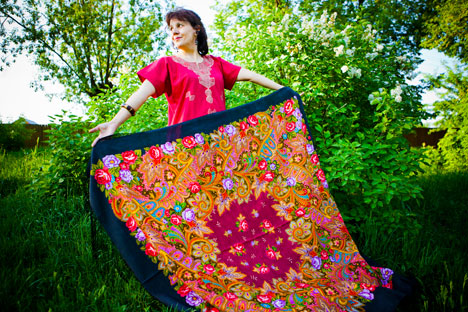
More than 600 types of shawls, kerchiefs and scarves, both for men and women, are produced, using 2000 patterns. Photo: Kirill Lagutko
The Pavlovsky Posad shawl factory is an exception to the rule for Russia: it is more than 200 years old, having survived the Russian Revolution and civil war, two World
The factory’s longevity might be attributed to its ability to adapt and change with the times. In 1860, under the leadership of Ivan’s descendent Yakov Labzin and his assistant Vasily Gryaznov, the factory adopted modern methods of production, printing patterns onto the shawls. In 1869, Vasily Gryaznov died and until the October
- 56 miles: distance between Pavlovsky Posad and Moscow
- 60,000 people: Pavlovsky Posad’s population
- 10 hectares: territory belonging to the factory
- 100 percent: the factory’s private capital
- 600 employees (Before the October Revolution of 1917, there were 4,500 employees, and 2,500 during the Soviet era)
“In Soviet times, we had no competition, but in the current market economy conditions, including competition from cheaper alternatives from Eastern Europe, we had to introduce some alterations and gradually upgrade the production, largely thanks to the state support and subsidies for the craft industry. Now we use Italian-made lines of printing machines,” said Deputy Director Vyacheslav Dolgov. “Our enterprise has a complete production cycle, except for sheep breeding.” At present, the Pavlovsky Posad shawl factory is the only textile factory in Russia that produces both the fabrics it works with and the end product.
- 1,000,000: the total number of shawls and kerchiefs produced annually (20,000,000 shawls and kerchiefs were produced in the Soviet era)
- Designers create new models every two months
- 80 percent of all sales are concentrated in Russia, 10 percent in Turkmenistan and 10 percent in other countries, including Europe.
Dolgov notes one other way the factory has embraced modernity: “We sell our products through our Internet site as well: over 200,000 people used this option to buy our shawls. There is a forum on the site, which enabled
Pavlovsky Posad shawls are always visible on Russian Orthodox women on their way to church, and not just because they are attractive. Vasily Gryaznov is actually an Orthodox saint.
“Vasily Gryaznov was not only a forward-looking
All rights reserved by Rossiyskaya Gazeta.
Subscribe
to our newsletter!
Get the week's best stories straight to your inbox